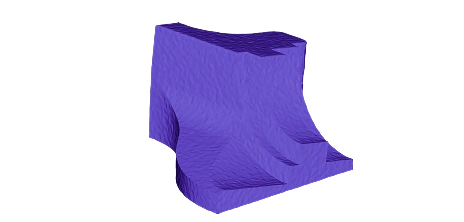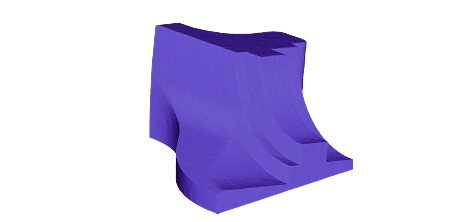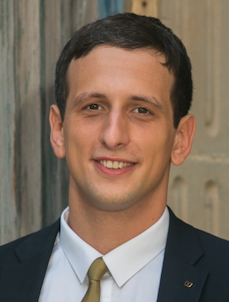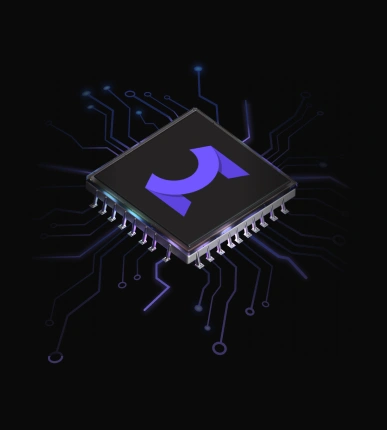- Published: 2025-07-30
- Updated: 2025-08-26
- MeshLib Team
Mesh Smoothing Function
Mesh smoothing refers to a group of algorithms, some iterative and some none-iterative, designed to reposition vertices in a 3D model to reduce noise and improve surface quality. While smoothing adjusts vertex locations, it preserves the overall object topology. That is, no new faces are added or removed. The goal is to achieve a smooth mesh that better reflects the intended shape, without sharp noise artifacts or irregularities.
Mesh smoothing plays a crucial role in various technical fields:
- 3D processing. A smooth mesh is often the first step in preparing scanned data or raw geometry for further operations;
- Computational geometry. Various geometric algorithms, especially those involving curvature estimation, re-meshing, or collision detection, require a well-distributed vertex layout.
- Computer graphics. Visual artifacts like shading bands or jagged silhouettes often result from uneven geometry.
It makes sense to smooth a mesh in many fields, including:
- 3D modeling. Smoothing is often used after sculpting, retopology, or reconstruction to clean up small defects and improve the appearance of geometry before subdivision or Boolean operations.
- Simulation. Finite element and fluid simulations depend on quality. A smooth mesh leads to better-conditioned solvers and fewer numerical instabilities.
- Additive manufacturing. Slicing engines perform better with both clean and smooth surfaces. Mesh smoothing helps eliminate jagged edges and tiny distortions. Otherwise, these could affect print quality.
- Scientific visualization. In such domains as bio imaging or geology, smoothing noisy scan data makes anatomical or structural patterns easier to observe and interpret.
Mesh Smoothing Algorithms & Techniques
Speaking of various mesh smoothing methods, the following ones on the table certainly deserve our attention:
Hole Filling Parameters
This one moves every vertex toward the centroid of its one‑ring neighbors. Such a step averages positions and knocks out high‑frequency noise. Simple and fast, however, it might shrink the model, unless you employ cotangent or scale‑dependent weights.
Taubin
As for this one, it runs one positive Laplacian step followed by a slightly larger negative step, which cancels the volume loss while still damping noise. Think of it as two quick pushes, first out, then in, that leave the object the same size but much smoother. Though more stable than plain Laplacian, it scales poorly on extremely dense meshes.
HC Laplacian
Here, we add an edge‑length ‘feedback’ pass after the Laplacian move, pulling vertices back toward their original edges. The result keeps crisp boundaries and overall volume better. It balances smoothing with shape retention better than standard Laplacian, but takes more time per iteration and may leave surface irregularities.
Bilateral and feature‑preserving filters
One weights each neighbor by both spatial distance and normal similarity, so diffusion happens only within nearly coplanar regions. This smooths broad areas yet respects sharp creases, ridges, and folds. These are excellent at preserving features while cleaning noise across large surfaces. However, they are slower.
Implicit fairing
We evolve the surface by its mean curvature via a backward‑Euler solver. Large time steps erase heavy noise while remaining numerically stable. Imagine the object melting uniformly like warm wax. It is ideal for removing severe noise while keeping numerical stability. Concurrently, it tends to shrink the surface.
Curvature‑adaptive approach
This one solves an edge‑aware diffusion equation that diffuses along the surface much more than across high‑curvature directions. Boundaries and corners stay intact while flat areas even out. It performs well and handles irregular meshes with ease thanks to per-vertex diffusion control. On the downside, it requires accurate curvature estimation and careful parameter tuning.
Having overviewed what exists in our professional domain, let’s now focus on MeshLib’s smooth mesh functions. All in all, what we do is offer basically Laplacian functions that sample smaller neighborhoods and add a built-in volume bias, so that massive meshes smooth interactively without shrinking.
How to Make 3D Meshes Smoother
Whenever you need to smooth meshes, between others, our MeshRelax algorithm is your first stop. All options keep topology intact and run in a few iterative passes, yet, each targets a slightly different pain point:
Core smoothing operators
- relax (or simple Relax) is our fastest noise killer. It pulls each vertex toward the centroid of its 1‑ring neighbors. Use iterations for a quick polish but expect some global shrinkage.
- relaxKeepVolume features same idea, however, ads a corrective term that tries to maintain overall volume. It is ideal for scanned parts or print‑ready geometry where size matters.
- relaxApprox will fit a local plane or quadric patch around each vertex, then will project the vertex onto that surface. As such, it reeps subtle curvature better than centroid moves. Note that quadric mode is slower but more faithful.
- equalizeTriAreas iteratively shifts vertices so neighboring triangles converge toward a uniform area, boosting element quality for FEM / CFD. Remember, that it does not smooth the surface itself. So finish with a Delaune-based topology improvement round for cleaner geometry if the output looks strange.
In addition to that, there are quality boosters at your disposal:
- removeSpikes runs Relax only on vertices whose dihedral angle is above a threshold, flattening isolated spikes.
- smoothRegionBoundary straightens the outline of a selected face set without touching its interior.
- hardSmoothTetrahedrons snaps ‘central’ vertices of tetra‑shaped artifacts into the surrounding face plane. As such, it is rarely needed for typical pipelines.
- positionVertsSmoothly repositions selected vertices to create a smooth surface both inside the region and along its boundary. This method supports custom weights.
We also offer advanced denoising via meshDenoiseViaNormals.
- It runs a Mumford–Shah–style two‑stage solver. First, we smooth per‑vertex normals, then re‑position vertices so the object follows those normals. The result wipes micro‑noise but locks sharp edges, giving you a visibly smooth model without rounded corners.
- meshDenoiseViaNormals works well after a quick relaxation pass when ordinary smoothing has already removed the worst spikes.
- Core knobs (all in DenoiseViaNormalsSettings):
- beta stands for edge sensitivity.
- gamma is for overall smoothing strength.
- normalIters, pointIters: here, more iterations mean cleaner result but longer run time.
- guideWeight > 0 pins vertices toward their originals to fight global shrink.
- fastIndicatorComputation. Here, true makes the edge‑indicator phase approximate but 3‑4× faster.
- limitNearInitial + maxInitialDist clamp how far any vertex may wander.
- outCreases is an optional thing that returns where the algorithm thinks the sharp edges are.
Who Should Try Our SDK for Right Away?
- Product design and 3D printing
- Visual effects
- Cultural‑heritage preservation and archaeology
Python & C++ Code to Smooth Mesh
from meshlib import mrmeshpy as mm
# Load mesh
mesh = mm.loadMesh("mesh.stl")
# Create parameters for adding noise
nSettings = mm.NoiseSettings()
nSettings.sigma = mesh.computeBoundingBox().diagonal()*0.0001
# Add noise to mesh
mm.addNoise(mesh.points,mesh.topology.getValidVerts(),nSettings)
# Save noised mesh
mm.saveMesh(mesh,"noised_mesh.stl")
# Denoise mesh with sharpening for sharp edges
# see the article "Mesh Denoising via a Novel Mumford-Shah Framework"
mm.meshDenoiseViaNormals( mesh )
# Save denoised mesh
mm.saveMesh(mesh,"denoised_mesh.stl")
#include <MRMesh/MRAddNoise.h>
#include <MRMesh/MRBox.h>
#include <MRMesh/MRMesh.h>
#include <MRMesh/MRMeshLoad.h>
#include <MRMesh/MRMeshSave.h>
#include <MRMesh/MRNormalDenoising.h>
int main()
{
// Load mesh
auto mesh =
MR::MeshLoad::fromAnySupportedFormat( "mesh.stl" );
assert( mesh );
// Add noise to the mesh
MR::addNoise( mesh->points, mesh->topology.getValidVerts(), {
.sigma = mesh->computeBoundingBox().diagonal() * 0.0001f,
} );
// Invalidate the mesh because of the external vertex changes
mesh->invalidateCaches();
// Save the noised mesh
MR::MeshSave::toAnySupportedFormat( *mesh, "noised_mesh.stl" );
// Denoise the mesh with sharpening for sharp edges
// see the article "Mesh Denoising via a Novel Mumford-Shah Framework"
MR::meshDenoiseViaNormals( *mesh );
// Save the denoised mesh
MR::MeshSave::toAnySupportedFormat( *mesh, "denoised_mesh.stl" );
}


Step-by-Step Surface Mesh Smoothing Workflow
- Step 1. Open your model. Load any 3D file.
- Step 2. Add some noise. To test how smoothing works, add small random bumps to the surface, just enough to see the difference.
- Step 3. Save the noisy version. This lets you compare before and after. You’ll see a slightly messy objects with micro‑artifacts.
- Step 4. Denoise. Run meshDenoiseViaNormals() function. It smooths flat areas but protects sharp edges and corners.
- Step 5. Save the clean result. Now you have two files. First, the noisy object and, second, the cleaned and smooth mesh, which is totally ready for printing, rendering, or further editing.
MeshLib Library for Mesh Smoothing
Whenever you need to smooth meshes, between others, our MeshRelax algorithm is your first stop. All options keep topology intact and run in a few iterative passes, yet, each targets a slightly different pain point:
Setup Guides
Language Support
- C++: Full support on all platforms with no restrictions.
- Python: Works with Python 3.8 to 3.13 across operating systems:
- Windows: 3.8–3.13
- macOS: 3.8–3.13 (except 3.8 on Intel Macs)
- Linux: 3.8–3.13 on any manylinux_2_31+ system
Find the full source code on GitHub
Supported File Formats
Format | Import | Texture Support | Color Support | Export |
|---|---|---|---|---|
STL | Yes | No | No | Yes |
OBJ | Yes | Yes | Yes | Yes |
OFF | Yes | No | No | Yes |
DXF | Yes | No | No | Yes |
STEP | Yes | No | No | No |
STP | Yes | No | Yes | No |
CTM | Yes | No | Yes | Yes |
3MF | Yes | Yes | Yes | No |
MODEL | Yes | No | No | No |
PLY | Yes | No | Yes | Yes |
GLTF | Yes | Yes | Yes | Yes |
What our customers say
Thomas Tong
Founder, Polyga

Gal Cohen
CTO, customed.ai

Mariusz Hermansdorfer
Head of Computational Design at Henning Larsen Architechts

HeonJae Cho, DDS, MSD, PhD
Chief Executive Officer, 3DONS INC

Ruedger Rubbert
Chief Technology Officer, Brius Technologies Inc








Start Your Journey with MeshLib
MeshLib SDK offers multiple ways to dive in — from live technical demos to full application trials and hands-on SDK access. No complicated setups or hidden steps. Just the tools you need to start building smarter, faster, and better.

